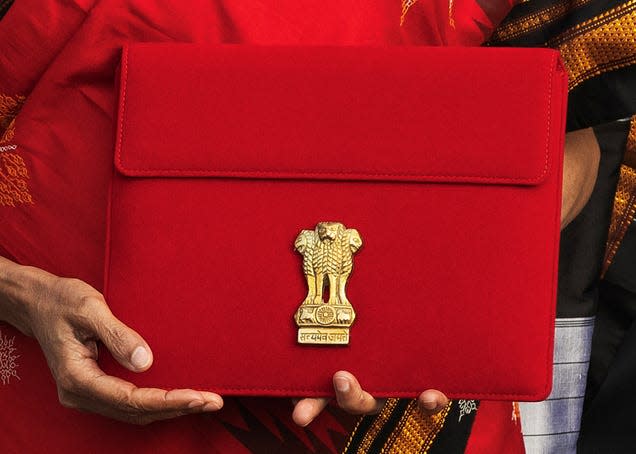The Quartz guide to the Indian budget's extravagant jargon

In a 60-page speech today (Feb. 1), Nirmala Sitharaman, India’s finance minister, laid out how her government plans to spend its money over the next year. The budget exercise, an annual tradition, delineated tax rebates and investments across sectors to boost the Indian economy— which, Sitharaman said, has increased in size “from the 10th biggest to the 5th largest globally in just 9 years (pdf).”
The budget is as much a political exercise as a fiscal one—in this case, very literally so. India’s governments have always displayed an absurd love for acronyms and monikers for their schemes, but prime minister Narendra Modi has been particularly fond of them. In Sitharaman’s speech—delivered just 14 months before the next election—the nomenclature ran heavily political. The names of flagship schemes either acknowledged Modi or derived from Hindi and Sanskrit terms, the kind favored by Modi’s Bharatiya Janata Party as part of its devotion to Hindu ideology.
Read more
To follow along in the speech, therefore, readers will find this glossary essential:
👴🏻 Antyodaya: Literally, “the rise of the last man,” or the welfare of people at the so-called bottom of the pyramid. First mentioned in the 2017-18 budget, Mission Antyodaya aims to optimize the resources of Indian ministries so as to best develop rural areas.
🍯 Amrit kaal: An “auspicious time” or a “time of nectar,” first used by Modi in 2021. Modi employed the word while describing his vision for India’s next quarter-century, saying: “The goal of ‘Amrit Kaal’ is to ascend to new heights of prosperity for India and the citizens of India.” Apparently, that goal is already in sight—at least according to Sitharaman, who called her budget “the first...in Amrit kaal.”
🌄 Amrit Dharohar: Literally meaning “divine heritage,” this is the name of a new government scheme, to be implemented over three years, to encourage the optimal use of wetlands, and enhance bio-diversity, carbon stock, and eco-tourism opportunities.
🇮🇳 BHARAT Shri: An acronym for Bharat Shared Repository of Inscriptions, a digital epigraphy museum, to be set up with the digitization of 100,000 ancient inscriptions.
💩 GOBARdhan scheme: An acronym for Galvanizing Organic Bio-Agro Resources Dhan, a program to farmers manage their organic waste. The Hindi word “Gobar” means cow dung, while “dhan” means wealth. In Sitharaman’s budget, she announced 500 new “waste-to-wealth” biogas plants under the GOBARdhan scheme.
👮🏽Mission Karmayogi: The Hindi-Sanskrit word “karmayogi” describes someone who works hard, both physically and mentally. Modi’s supporters often refer to him as one. Sitharaman used “Mission Karmayogi” to label a scheme to upskill civil servants.
🍧 MISHTI: A Bengali word meaning “sweet,” MISHTI referred, in the budget speech, to a new afforestation scheme. Unsurprisingly, it is an acronym: Mangrove Initiative for Shoreline Habitats & Tangible Incomes.
🌳 mission LiFE: Mentioning the Modi government’s goals towards a greener future, the minister invoked “mission LiFE” in talking about a scheme to combat the effects of climate change.
👩🏻🎨 PM Vikaas: An acronym for “PM Vishwakarma Kaushal Samman,” where “PM” stands for “prime minister.” “Vishwakarma” is a Hindu deity, “Kaushal” and “Samman” mean “craft” and “respect.” “PM Vikaas” is the name for a package of assistance for traditional artisans and craftspeople.
🙏🏼 PM-PRANAM: In itself, “Pranam” is a respectful greeting loosely equivalent to “Namaste” or “Hello.” But the whole term is an acronym for a government program: “PM Programme for Restoration, Awareness, Nourishment, and Amelioration of Mother Earth.” PM-PRANAM incentivizes states and union territories to promote alternative fertilizers and balanced use of chemical fertilizers. Needless to say, “PM” stands for “Prime Minister.”
🥙 PMGKAY: An acronym for “PM Garib Kalyan Anna Yojana,” a food security welfare scheme announced in 2020 during the pandemic.
🍹Panchamrit: Made up of two Hindi-Sanskrit words: “Panch,” meaning “five,” and “Amrit,” which refers to the nectar of immortality. Sitharaman used the term while listing the budget’s priority of green growth. In 2021, concurrent with the COP26 climate summit, Modi had laid out a five-commitment plan to reach net zero by 2070: hence “panchamrit.”
🎑 Shree Anna: Translating directly as the words for “prosperity” and “grain,” the term cropped up in the budget speech in the context of indigenous grains offering vaunted health benefits.
🤝🏻Vivad se Vishwas: The phrase, roughly meaning “from conflict to trust,” was used in the context of small and medium enterprises (MSMEs). In order to provide relief to MSMEs, Sitharaman said that, in cases of failure by MSMEs to fulfill contracts during pandemic, 95% of any forfeited amount would be returned to them by the government.
More from Quartz
Sign up for Quartz's Newsletter. For the latest news, Facebook, Twitter and Instagram.

